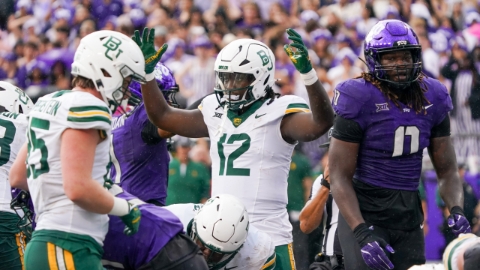SurfingBear said:
RightRevBear said:
I do find it interesting that the only primary source material we have is a letter written by a lady over 50 years after the event supposedly occurred.
Casting aside any aspersions about Mrs. Sara Rose Kendall Irvine as to her character due to not knowing her, and I will give a fellow alum the benefit of the doubt. How do we not know that she mis-remembered or had dementia?
Also, maybe the committee changed it to gold, instead of dandelion yellow, because they didn't like the yellow. They might have not told her this due to not wanting an argument or to make her upset. This never happens in Baptist institutions.
Looking at this with a critical eye, I think legend is about the only way to describe the retelling over 50 years later with no corroborating facts. Do we have a record of Mrs. Irvine and other students meeting with the president concerning school colors? Are there any school newspapers covering the decision to make these the school colors? Are there any other documents that say she was on this committee or any minutes on their meeting discussions?
I say all of this to say that this story does not have enough supporting evidence to justify that it is any more than a legend.
What we do have is an Alma mater written in 1906 the says Green and Gold? I want gold, not mustard yellow.
Let us review your "critical eye".
Fact, Ms. Sara Rose was as primary a source as you can get. Still, you ask us to consider some outlandish hypotheticals to refute her with no proof of your own.
You argue as follows:
1: She may have had dementia...? Erroneous unless you have proof. Even then, that doesn't mean she is mistaken on this fact.. Long term memory is not always affected the same as short term memory.
2: She may have misremembered picking the school colors...? Unlikely given the magnitude of such an event. She even committed her memory to writing. Your assertion is baseless and purely hypothetical.
3: Baylor changed to the color to "gold" and misled her because they are Baptist...? Sounds suspect at best and scandalous at worst. This contention should be dismissed unless you can proffer some evidence immediately.
4: If there are not records it's just legend... First, Baylor adopted and published her version of events. So legend or not, it's official. Second, there is the letter you reference and Baylor is not refuting it. In other words, it's more than legend, it's tradition.
Basically, a critical analysis leads to one conclusion, "gold" and "yellow" are to be viewed artistically, NOT literally to mean the metallic element on the periodic table. In fact, the dandelion is described as being "golden" yellow.
You have not looked at this with a critical eye; your motives betray your ability to be critical... and I quote "I want gold not mustard yellow."

Ok let's go through each one.
Prove she is a primary source. The burden is on you. The rule of thumb is that the source has to be proven reliable. We have nothing but a letter from her stating that she is the originator over 60 years (1897 to 1959) after it supposedly occurred. Also, the years on her story are interesting. She had to be at least a six year student. (I do not say this negatively. I took an extra year and a half on my masters due to getting married.) If it was first used in March 25th 1897, but it was probably 1896 when she saw the weeds. Dandelions appear in March, but the big blooms are in late April in Central Texas.
Even if they bloomed early, It would have been difficult to return from the trip, the committee make a decision, get admins. approval, and coordinate with the glee club by March 25, 1897. The letter itself says the colors were probably adopted in 1897.
1. You are right about not knowing and that long-term memory is usually the last to go. I made this point in light of no other evidence to her 60+ year old story. We don't know her mental state. I wouldn't throw this out just on this hypothetical, but we are assuming she is a good historian of the event 60+ years later if we accept her statement.
2. You are right it is completely hypothetical. I did not portray it as anything but hypothetical, but to state something as fact from one source with no other supporting evidence does not make it a trustworthy source. She did commit it to writing 60 years later which makes me more skeptical.
3. I say this as an active Baptist minister. There are plenty of times in which committees will make a soft suggestion to get their way. Let's call it Gold, instead of yellow, when they have no intention of it being yellow.
4. In a blog post they recounted the story. In their branding colors page they say it is a legend. You say it is legend when the people who are responsible for proper color branding at Baylor say it is legend. Also many legends can become tradition.
My whole point is that stating something is fact based off of one piece of evidence from a person who is the "hero" of the story is not good scholarship. This is compounded by the length of time from when it supposedly occurred to when she wrote the letter. I find it strange that there is no other supporting evidence.
What I do know is that golden yellow is not gold. Our Alma mater says gold. Our own website says that it is a legend. The story that has been published multiple times is based off of one letter with no other corroborating evidence. I am a person that believes sources have to be proven, not disproven, because this leads to bad scholarship and reporting.
It is like the people who say that the COVID-19 vaccines contained microchips that the government uses to track us. They offer "proof", but it is not reliable. I am not going to accept it at prima facie. I am going to use my critical mind to say this doesn't make sense when the government can track most of the population through their cell phones already. Why would the government care about putting trackers in us when we voluntarily choose to carry a tracker with us everywhere we go?
What I am saying is for this story to be accepted as fact you need to have more supporting evidence.







